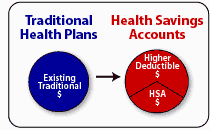When we first got into the health insurance business, it was quite common for our clients to opt for policies with middle-of-the-road deductibles and copays for office visits. Over the last decade, however, we’ve seen more and more clients (including ourselves) choosing high deductible policies – often HSA-qualified – that often don’t include office visit copays. Instead of the traditional copays, office visits are counted towards the deductible, and not covered until the deductible is met.
Some people genuinely prefer it this way. They are rarely sick and want to set up a health savings account for the tax benefits. But a lot of people are opting for higher deductible policies without copays as a way to keep the premiums affordable, even though they would prefer to have a more traditional policy with predictable office visit copays.
For people in the Fort Collins, Colorado area, a new health care provider called GeneralCare Medical Clinic might be a good option to combine with a high deductible “catastrophic” health insurance policy. Members pay $600/year to join, and then office visits (including sutures, lab work and x-rays) at the clinic are $30. There are no limits on the number of visits, and the clinic does not exclude pre-existing conditions. For someone who wants the benefit of unlimited office visits with a predictable set charge for each visit, a membership to a clinic like this might be less expensive than the additional premium that would be charged by their health insurance carrier to have unlimited office visits on their policy.
However, this is not going to be a perfect solution for everyone. The $600/year charge is a per-person fee, so it would start to add up quickly if you have a family. I called the clinic to double check, and they do not have a discounted family rate – each person would have to pay $600/year, plus the $30 charge for each office visit. For someone who anticipates frequent office visits, the clinic membership likely would pay for itself. But if a person only goes to the doctor a few times per year, it would probably end up being less expensive to simply pay out of pocket for office visits.
If a person absolutely cannot afford a health insurance policy, a clinic membership is likely better than nothing at all, simply because it may make people less likely to put off going to the doctor when something may be seriously wrong. If an employer is paying for the membership (which is apparently often the case) the member would only have to pay the $30 fee to see a doctor. As long as the members clearly understand exactly what is – and isn’t – included, there’s no harm in having a clinic membership. I can see potential problems however, if people confuse having a clinic membership with having health insurance. Just as in the case of “mini-med” plans, there could be a downside. If employees get a membership through their employer and assume it’s the same thing as having health insurance, they might believe that they don’t need any additional coverage, and could find themselves in a very tough spot if they have a medical incident that requires hospitalization or extensive services not provided by the clinic. The clinic is very clear in noting that their membership is NOT health insurance, and that the service is intended for people who are unable to obtain or afford health insurance, or for those who are underinsured for things like urgent care and office visits.
It’s always good to see new innovations that help to expand access to healthcare, and clinic memberships that allow people to cover their day to day medical expenses with a predictable annual fee and low cost appointments is likely to be quite popular, especially among people who can’t afford comprehensive health insurance. But as with any other product, a clear awareness of what you’re purchasing (or being offered, if an employer is covering the cost) will help to avoid future surprises.



